WHO statement on mortality in Al Hol camp, Syria
22 September 2019 –The World Health Organization (WHO) has serious concerns over recent reporting of an increase in the number of child deaths in Al Hol camp. Such reporting has provided an inaccurate analysis on under-5 mortality, misrepresented some of the data, and overstated the gravity of the health situation in the camp.
While health needs in both the Annex – which houses foreign nationals - and the rest of the camp remain acute, overall mortality rates have been within international standards since April 2019; under-5 mortality rates have remained within international standards since May 2019. Contrary to the inaccurate reporting, there has been no increase in child deaths since March and mortality rates have remained stable over the past 6 months. Given the challenging operating environment and large health needs in Al Hol, these outcomes reflect well on the effectiveness of the collective humanitarian response in the camp.
The number of deaths reported decreased from 52 deaths during the week of 5–11 March, to 3 deaths during the week of 27–31 August. In total from 4 December 2018 to 31 August 2019, 406 deaths were registered in the camp, including 313 children (77%) under the age of 5. The high proportion of childhood deaths is largely due to the unusual demographics of the camp – the vast majority of residents are women and children – of which children under 5 currently represent 28.5% of the overall camp population.
WHO and health partners are working tirelessly to respond to health needs in Al Hol camp and have made significant efforts to scale up to the provision of health services.
Access to health care for camp residents is being progressively expanded, with 3 field hospitals, 18 static medical points, 8 mobile teams, 3 delivery clinics, 2 vaccination teams, and two family well-being centres providing services to the camp’s inhabitants. 12 medical points are reporting cases of infectious disease to the camp’s disease surveillance system.
WHO and partners will continue to work in a coordinated manner to further increase the range, coverage and quality of health services in the camp – and to avert all preventable deaths. Concerns regarding access to health care services in the Annex, as well as the high percentage of deaths in the community are shared by WHO and health partners, who are working vigorously to address these issues.
While continuing to expand access to humanitarian assistance is vital, WHO affirms that finding durable solutions for the residents of the camp must remain a major priority for the international community.
منظمة الصحة العالمية تقدم الرعاية الصحية للنازحين في شمال غرب الجمهورية العربية السورية
2 تموز/يوليو 2019 – نشرت منظمة الصحة العالمية وشركاؤها ثماني عيادات متنقلة منذ بداية أيار/مايو 2019 لتلبية احتياجات النازحين مؤخراً في شمال غرب سوريا. والعيادات المتنقلة هي غالبًا المصدر الوحيد للرعاية الصحية للذين حرموا من القدرة على الوصول إلى الخدمات الصحية المنتظمة نتيجة للصراع المستمر في المنطقة. وتقدم كل عيادة متنقلة، في المتوسط، ما بين 1500 و1800 استشارة صحية كل شهر، وتكفل إحالة الحالات المحتاجة لمزيد من الرعاية إلى أقرب مرفق صحي.
Iran floods leave people with limited access to life-saving health services
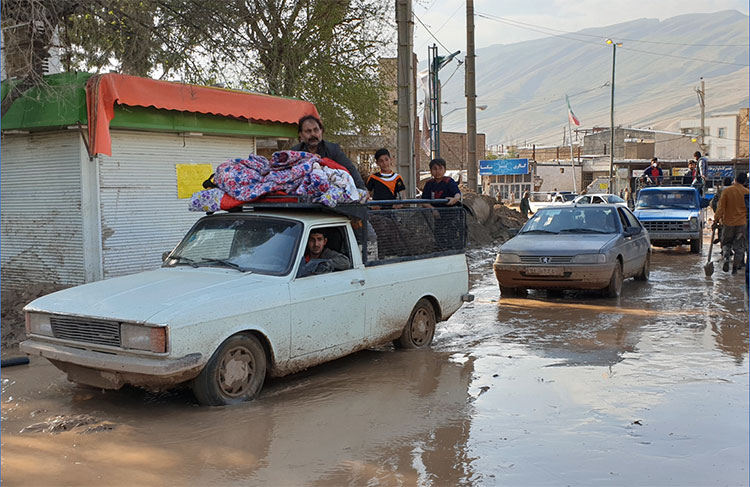
10 May 2019 - On 18 March 2019, a flood hit the eastern part of Mazandaran and Golestan provinces after four days of heavy rain. A few days later, additional floods in the west, southwest, and northeast of the country affected thousands of people. Shortly after, a third wave of heavy rains commenced.
As of 9 April, a total of 28 provinces have been affected by the floods (out of 31 provinces in total).
Overall, a total of 42 269 129 people have been affected by the floods across, almost 392,859 people have been displaced, 84 have died, and around 20,573 persons were injured.
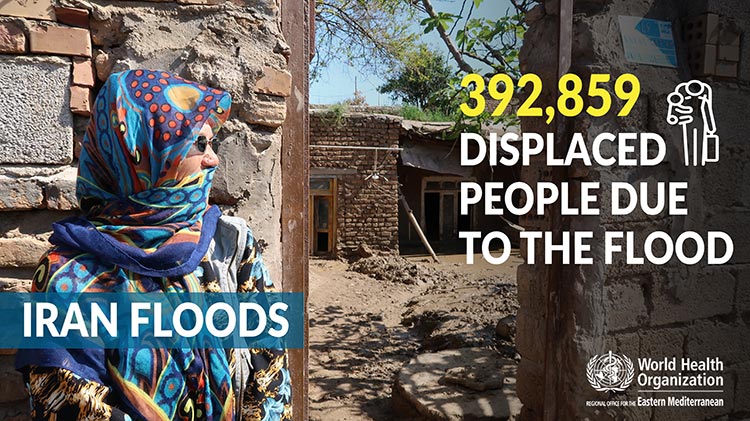
The total estimated population in need of immediate health care assistance is around 3,000,000 people.
People in need for health care assistance
People internally displaced due to the flood
Children affected in the most vulnerable areas
Health facilities damaged in the most affected areas
Provinces affected by the floods (out of 31 provinces)
Deaths (84) and injuries (20573) due to the floods
The floods have fully and partially destroyed 1040 health facilities and 81 hospitals, leaving patients with limited access to essential and life-saving health services.
In some provinces, health facilities are not functional due to inaccessibility due to road blocks, running water, and landslides as well as due to standing water in buildings.
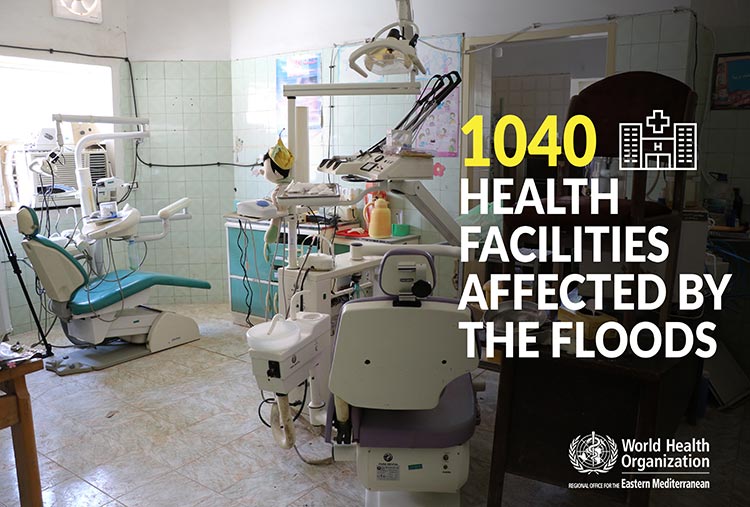
Health workers are not able to reach populations in need, as transportation and infrastructure has been destroyed.
Dr Christoph Hamelmann - WHO Representative for the Islamic Republic of Iran
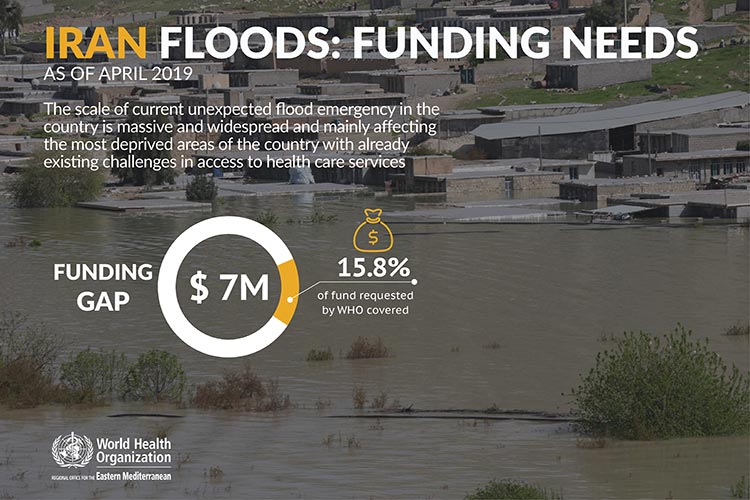
Related link
هلا خضري: التفاني في العمل في حالات الطوارئ
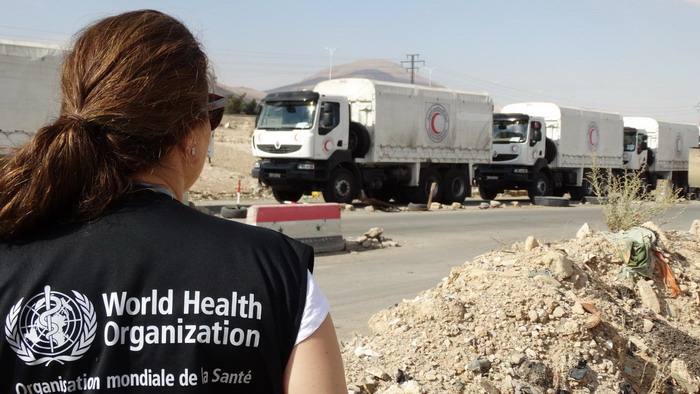
"عندما أرى أعداد السكان المحاصرين في الدول التي تعاني من أزمات طارئة بالمنطقة، بما فيهم الأطفال المصابين بسوء التغذية الحاد، أكون أكثر إصراراً على بذل كل ما بوسعي للمساهمة في إنقاذ حياتهم"، تقول هلا خضري، وهي مديرة تقنية في إدارة برامج الطوارئ الصحية بالمكتب الإقليمي لمنظمة الصحة العالمية لشرق المتوسط.
التحقت هلا بمكتب منظمة الصحة العالمية في سوريا بعد أشهر قليلة من حصولها على درجة الماجستير في علوم التغذية من الجامعة الأمريكية في بيروت في ٢٠١١، حيث تولت إدارة أنشطة التغذية الاعتيادية والطارئة.ومع اندلاع الأزمة، شاركت هلا بشكل فاعل في دعم عمليات الاستجابة لحالات الطوارئ في منظمة الصحة العالمية، مع التركيز على أنشطة التغذية. وعلى الرغم من ضغوط العمل الشديدة وبعض "اللحظات المؤلمة" التي واجهتها، خصوصاً أثناء العمل الميداني وبالقرب من الخطوط الأمامية، تحتفظ هلا بشغفها الدائم المتمثل بالعمل في مجال الطوارئ الصحية.
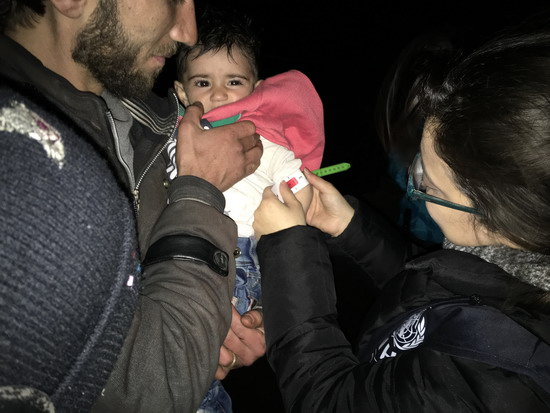
قالت هلا: "في البداية، كان العمل خلال فترة الأزمة بما يتطلبه من زيارات ميدانية للمناطق التي مزقتها الحرب أمراً مرهقاً للغاية. شاهدت العديد من الأطفال الذين يعانون من سوء التغذية في سوريا، وبعضهم بحاجة إلى عناية طبية فورية. كما واجهت الكثير من التحديات بما فيها عدم إمكانية الوصول لبعض المناطق وانعدام الأمن وغيرها من المواقف الصعبة. لكني وضعت كل طاقتي في عملي".
خلال عملها في مكتب منظمة الصحة العالمية في سوريا، لعبت هلا دوراً أساسياً في التخطيط والاستجابة للاحتياجات الصحية والتغذوية للسكان في جميع أنحاء سوريا. كما ساهمت في تطوير خطط الاستجابة والطوارئ بما فيها عمليات الإخلاء من حلب الشرقية والاستجابة للنازحين في شمال سوريا إضافة لاستجابة المنظمة في المناطق المحاصرة وتلك التي يصعب الوصول إليها.
في تشرين الثاني ٢٠١٧، انضمت هلا لفريق الطوارئ الصحية في المكتب الإقليمي لمنظمة الصحة العالمية لشرق المتوسط بهدف دعم عمل المنظمة في الإقليم. "أتاحت لي هذه الفرصة توسيع آفاقي وتقديم الدعم الذي كنت أقدمه لدول أخرى تعاني من أزمات طارئة، بما فيها العراق وسوريا"، تقول هلا.
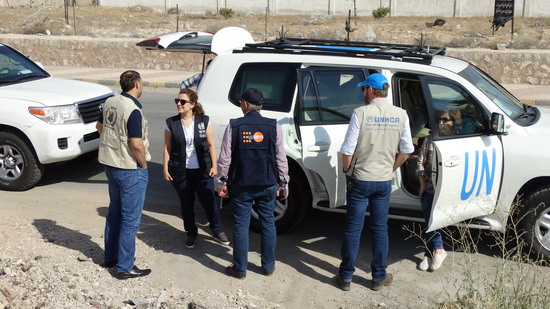
ومؤخراً، شاركت هلا بفعالية في دعم عمليات الاستجابة الصحية في شمال سوريا، حيث يحتاج مئات الآلاف من السكان بصور ماسة للمساعدات الإنسانية، بما فيهم عشرات الآلاف يعيشون ظروفاً قاسية في مخيمات ومناطق النزوح.
"تجربتي الإقليمية خلال السبعة عشر شهراً الماضية، إضافة إلى خبرتي السابقة في سوريا، كلاهما منحتني معرفة عميقة حول الاحتياجات الصحية والتغذوية والتنسيق للاستجابة لهذه الاحتياجات"، تقول هلا.
وتضيف: "العمل في برامج الطوارئ يسلط الضوء على زيادة حالات سوء التغذية الحاد بسبب استمرار الأزمات في أنحاء المنطقة. كمختصة في مجال التغذية، أشعر بالقلق بسبب عدد الحالات التي تتطلب العلاج في بعض الدول مثل الصومال والسودان واليمن. وعلى الرغم من الجهود الكبيرة التي بذلتها مختلف الوكالات والقطاعات للتعامل مع حالات سوء التغذية والتخفيف منها، إلا أن هناك حاجة لبذل المزيد من الجهد . والطريقة الأمثل لتحسين الوضع التغذوي تكمن في توحيد جهود جميع المعنيين والعمل معاً، وإلا فإن المنطقة ستعاني من مآزق كبيرة".
وتقول هلا: "طالما انا في الميدان وعلى تماس مباشر مع المحتاحين سأعمل كل ما بوسعي لتخفيف المعاناة عند الفئات الأشد ضعفاً. وكلما استذكرت المبادئ الإنسانية للأمم المتحدة، أدرك سبب اختياري العمل في القطاع الإنساني".


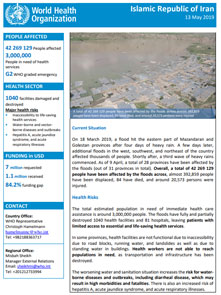 Donor alert 13 May 2019
Donor alert 13 May 2019